Related Research Articles

Euripides was a tragedian of classical Athens. Along with Aeschylus and Sophocles, he is one of the three ancient Greek tragedians for whom any plays have survived in full. Some ancient scholars attributed ninety-five plays to him, but the Suda says it was ninety-two at most. Of these, eighteen or nineteen have survived more or less complete. There are many fragments of most of his other plays. More of his plays have survived intact than those of Aeschylus and Sophocles together, partly because his popularity grew as theirs declined—he became, in the Hellenistic Age, a cornerstone of ancient literary education, along with Homer, Demosthenes, and Menander.

Polyphemus is the one-eyed giant son of Poseidon and Thoosa in Greek mythology, one of the Cyclopes described in Homer's Odyssey. His name means "abounding in songs and legends", "many-voiced" or "very famous". Polyphemus first appeared as a savage man-eating giant in the ninth book of the Odyssey. The satyr play of Euripides is dependent on this episode apart from one detail; Polyphemus is made a pederast in the play. Later Classical writers presented him in their poems as heterosexual and linked his name with the nymph Galatea. Often he was portrayed as unsuccessful in these, and as unaware of his disproportionate size and musical failings. In the work of even later authors, however, he is presented as both a successful lover and skilled musician. From the Renaissance on, art and literature reflect all of these interpretations of the giant.
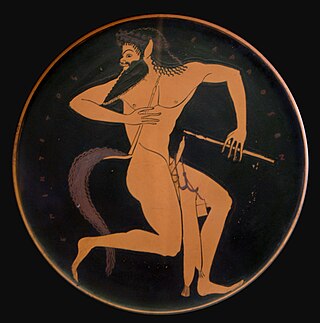
In Greek mythology, a satyr, also known as a silenus or silenos, and sileni (plural), is a male nature spirit with ears and a tail resembling those of a horse, as well as a permanent, exaggerated erection. Early artistic representations sometimes include horse-like legs, but, by the sixth century BC, they were more often represented with human legs. Comically hideous, they have mane-like hair, bestial faces, and snub noses and they always are shown naked. Satyrs were characterized by their ribaldry and were known as lovers of wine, music, dancing, and women. They were companions of the god Dionysus and were believed to inhabit remote locales, such as woodlands, mountains, and pastures. They often attempted to seduce or rape nymphs and mortal women alike, usually with little success. They are sometimes shown masturbating or engaging in bestiality.

The following outline is provided as an overview of and topical guide to theatre:

A playwright or dramatist is a person who writes plays.
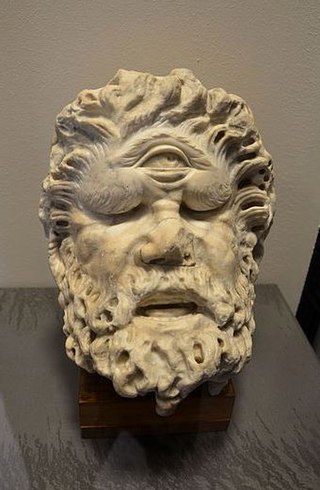
In Greek mythology and later Roman mythology, the Cyclopes are giant one-eyed creatures. Three groups of Cyclopes can be distinguished. In Hesiod's Theogony, the Cyclopes are the three brothers Brontes, Steropes, and Arges, who made for Zeus his weapon the thunderbolt. In Homer's Odyssey, they are an uncivilized group of shepherds, the brethren of Polyphemus encountered by Odysseus. Cyclopes were also famous as the builders of the Cyclopean walls of Mycenae and Tiryns.

Tragedy is a genre of drama based on human suffering and, mainly, the terrible or sorrowful events that befall a main character. Traditionally, the intention of tragedy is to invoke an accompanying catharsis, or a "pain [that] awakens pleasure,” for the audience. While many cultures have developed forms that provoke this paradoxical response, the term tragedy often refers to a specific tradition of drama that has played a unique and important role historically in the self-definition of Western civilization. That tradition has been multiple and discontinuous, yet the term has often been used to invoke a powerful effect of cultural identity and historical continuity—"the Greeks and the Elizabethans, in one cultural form; Hellenes and Christians, in a common activity," as Raymond Williams puts it.
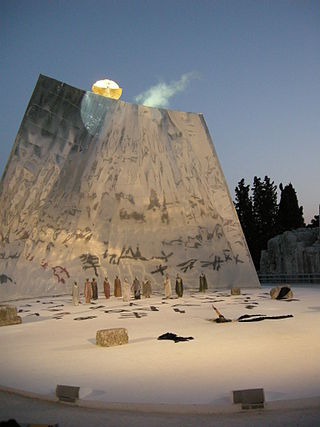
Deus ex machina is a plot device whereby a seemingly unsolvable problem in a story is suddenly or abruptly resolved by an unexpected and unlikely occurrence. Its function is generally to resolve an otherwise irresolvable plot situation, to surprise the audience, to bring the tale to a happy ending or act as a comedic device.
Medea is an ancient Greek tragedy written by Euripides. It is based upon the myth of Jason and Medea and was first produced in 431 BC as part of a trilogy; the two other plays have not survived. The plot centers on the actions of Medea, a former princess of the kingdom of Colchis, and the wife of Jason; she finds her position in the Greek world threatened as Jason leaves her for a Greek princess of Corinth. Medea takes vengeance on Jason by murdering his new wife as well as her own two sons, after which she escapes to Athens to start a new life.

Greek tragedy is one of the three principal theatrical genres from Ancient Greece and Greek inhabited Anatolia, along with comedy and the satyr play. It reached its most significant form in Athens in the 5th century BC, the works of which are sometimes called Attic tragedy.
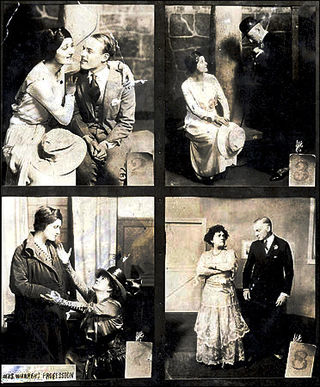
The problem play is a form of drama that emerged during the 19th century as part of the wider movement of realism in the arts, especially following the innovations of Henrik Ibsen. It deals with contentious social issues through debates between the characters on stage, who typically represent conflicting points of view within a realistic social context. Critic Chris Baldick writes that the genre emerged "from the ferment of the 1890s... for the most part inspired by the example of Ibsen's realistic stage representations of serious familial and social conflicts." He summarises it as follows:
Rejecting the frivolity of intricately plotted romantic intrigues in the nineteenth-century French tradition of the 'well-made play', it favoured instead the form of the 'problem play', which would bring to life some contemporary controversy of public importance—women's rights, unemployment, penal reform, class privilege—in a vivid but responsibly accurate presentation.

The satyr play is a form of Attic theatre performance related to both comedy and tragedy. It preserves theatrical elements of dialogue, actors speaking verse, a chorus that dances and sings, masks and costumes. Its relationship to tragedy is strong; satyr plays were written by tragedians, and satyr plays were performed in the Dionysian festival following the performance of a group of three tragedies. The satyr play's mythological-heroic stories and the style of language are similar to that of the tragedies. Its connection with comedy is also significant – it has similar plots, titles, themes, characters, and happy endings. The remarkable feature of the satyr play is the chorus of satyrs, with their costumes that focus on the phallus, and with their language, which uses wordplay, sexual innuendos, references to breasts, farting, erections, and other references that do not occur in tragedy. As Mark Griffith points out, the satyr play was "not merely a deeply traditional Dionysiac ritual, but also generally accepted as the most appropriate and satisfying conclusion to the city’s most complex and prestigious cultural event of the year."

Cyclops is an ancient Greek satyr play by Euripides, based closely on an episode from the Odyssey. It would have been the fourth part of a tetralogy presented by Euripides in a dramatic festival in 5th Century BC Athens. The date of its composition is unknown, but it was probably written late in Euripides' career. It is the only complete satyr play extant.

The Ichneutae, also known as the Searchers, Trackers or Tracking Satyrs, is a fragmentary satyr play by the fifth-century BC Athenian dramatist Sophocles. Three nondescript quotations in ancient authors were all that was known of the play until 1912, when the extensive remains of a second-century CE papyrus roll of the Ichneutae were published among the Oxyrhynchus Papyri. With more than four hundred lines surviving in their entirety or in part, the Ichneutae is now the best preserved ancient satyr play after Euripides' Cyclops, the only fully extant example of the genre. The manuscript is now kept in the British Library in London.

Psyché is an opera in a prologue and five acts composed by Jean-Baptiste Lully to a libretto by Thomas Corneille. Based on the love story of Cupid and Psyche, Psyché was premiered on April 19, 1678 by the Académie Royale de Musique at the Théâtre du Palais-Royal in Paris.

Drama is the specific mode of fiction represented in performance: a play, opera, mime, ballet, etc., performed in a theatre, or on radio or television. Considered as a genre of poetry in general, the dramatic mode has been contrasted with the epic and the lyrical modes ever since Aristotle's Poetics —the earliest work of dramatic theory.
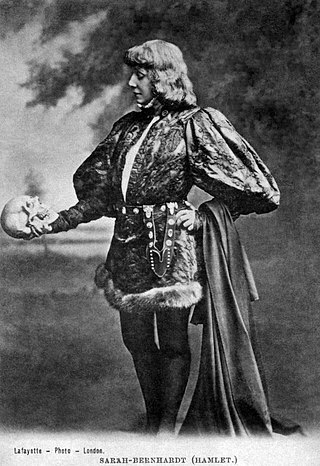
Theatre or theater is a collaborative form of performing art that uses live performers, usually actors or actresses, to present the experience of a real or imagined event before a live audience in a specific place, often a stage. The performers may communicate this experience to the audience through combinations of gesture, speech, song, music, and dance. It is the oldest form of drama, though live theatre has now been joined by modern recorded forms. Elements of art, such as painted scenery and stagecraft such as lighting are used to enhance the physicality, presence and immediacy of the experience. Places, normally buildings, where performances regularly take place are also called "theatres", as derived from the Ancient Greek θέατρον, itself from θεάομαι.

Comedy is a genre of fiction that consists of discourses or works intended to be humorous or amusing by inducing laughter, especially in theatre, film, stand-up comedy, television, radio, books, or any other entertainment medium. The term originated in ancient Greece: In Athenian democracy, the public opinion of voters was influenced by political satire performed by comic poets in theaters. The theatrical genre of Greek comedy can be described as a dramatic performance pitting two groups, ages, genders, or societies against each other in an amusing agon or conflict. Northrop Frye depicted these two opposing sides as a "Society of Youth" and a "Society of the Old". A revised view characterizes the essential agon of comedy as a struggle between a relatively powerless youth and the societal conventions posing obstacles to his hopes. In this struggle, the youth then becomes constrained by his lack of social authority, and is left with little choice but to resort to ruses which engender dramatic irony, which provokes laughter.
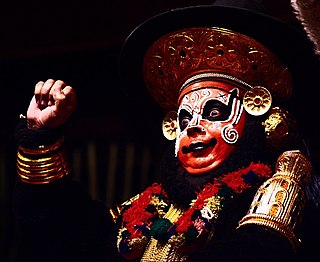
The history of theatre charts the development of theatre over the past 2,500 years. While performative elements are present in every society, it is customary to acknowledge a distinction between theatre as an art form and entertainment, and theatrical or performative elements in other activities. The history of theatre is primarily concerned with the origin and subsequent development of the theatre as an autonomous activity. Since classical Athens in the 5th century BC, vibrant traditions of theatre have flourished in cultures across the world.
High comedy or pure comedy is a type of comedy characterized by witty dialogue, satire, biting humor, wordplay, or criticism of life. The term high comedy was coined in England in 1877 by George Meredith for his Essay on Comedy.
References
- ↑ Francis M. Dunn. Tragedy's End: Closure and Innovation in Euripidean Drama. Oxford University Press (1996).